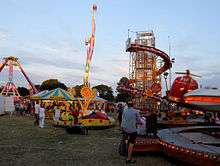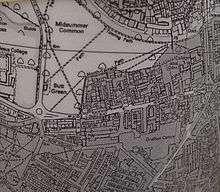Midsummer Common




Midsummer Common is an area of common land in central Cambridge, UK. The Cambridge Midsummer Fair held on the common is one of the oldest fairs in the UK and at one point was among England's largest. Today it exists primarily as an annual funfair with the vestige of a market attached.
The common borders the River Cam, houseboats are typically moored on the common's bank and most of the boathouses of the Colleges of Cambridge University are located on the opposite bank.
Events
Regular major events held on the Common include The May Day Fair, Strawberry Fair and an annual fireworks on Guy Fawkes Night, 5 November, which regularly attracts around 25,000 people e.g. in 2006.[1] Other events include fun runs and cycling events where the common is used as a start / finish point. A vigil and lantern floating ceremony took place on the common on Hiroshima Memorial Day in 2006.
Midsummer Fair
Cambridge Midsummer Fair was granted a charter by King John in 1211, and was originally held on or near the feast of St Etheldreda. Originally a trade fair, income from the event went to the Barnwell Priory.[2] In the sixteenth century the council and Mayor of Cambridge acquired the rights for the midsummer fair, with University Proctors retaining the right to search the fair for beggars, vagabonds and lewd women. The latter right in particular was hotly disputed.[2] In the 18th century was named the Pot fair due to the quantity of China traded there, and it was popular among gypsy travellers for trade in horse and cattle. In more recent times it has become a pleasure fair with amusements taking the place of trade in goods.[2]
Grazing

In March 2006 Geoffrey King, who later became the chairman of the Friends of Midsummer Common, put up £20 to investigate the possibility of introducing a "residents’ herd" of cows to the common, at a meeting of the Brunswick and North Kite Residents' Association.[3]
On 7 April 2007, after a period of time during which there had been no cattle on the common for a number of years, a small number of Red Poll bullocks, owned by a Cambridge resident, were introduced to the common. The grazing of cattle on the common is controversial, given the other uses to which the common is put, which may conflict with grazing.
Designation as a Common
Midsummer Common is registered pursuant to the provisions of the Commons Registration Act 1965.
Over time the common has become less like a typical British common and more like an area of city parkland. Street lighting and many tarmac paths are present on the common, and it has become a major route for those cycling and walking into work in the town from the surrounding expanding residential areas.
Cambridge City Council use the term park when describing the common:
Midsummer Common is classified as a Common located in an urban landscape in the centre of the city. The landscape setting affords the park opportunities to host large events in a variety of formats and scale.[4]
Jesus Green was separated from Midsummer Common in 1890 when Victoria Avenue was built. Jesus Green has since clearly become a park, and is no longer maintained in a state suitable for grazing. In 1930, Jesus College exchanged land currently between the Cutter Ferry bridge and Elizabeth Way for part of Butt's Green on the Jesus College side of Victoria Avenue.
Butt's Green
Butt's Green is an area which historically was used for archery butts, it is now essentially part of Midsummer Common. The Butt's Green area is less disturbed by events than the other areas and tends to have a wider diversity of plant life.
Antisocial behaviour
Midsummer Common, along with wide swathes of Cambridge City, has been a designated area under Section 20 Subsections (3) to (5) of the Anti-social Behaviour Act 2003. During much of Winter 2006/07 this order only applied in the evenings and apparently applied to the whole common; as of February 2007 a new authorisation which was brought into force on 3 January 2006 and lasting for six months was publicised. This only applied to the boundary path, and one corner of the common. The area of the common designated under the act does not include the public toilets or the area in which half of the City's redeployable CCTV cameras have been deployed within 100 m of each other.
To quote from the order made by Superintendent Simon Megikcs:
I give this order with the consent of the Cambridge City Council on the grounds that despite interventions to curb significant and persistent antisocial behaviour caused by groups of persons collecting and settling in the local area such problems persist. This has led members of the local business community to feel intimidated and harassed. Conduct of persons includes street drinking and rowdy behaviour verbally abusing and intimidating passers by, urinating in the street, allowing dogs to run off their leads, drug misuse in public toilets rough sleeping and aggressive begging and street drug misuse and purchase leading to an influx of street dealers.
This applies to a large area of Cambridge including Mill Road, Parker's Piece, Christ's Pieces, Midsummer Common, Brunswick Gardens and Riverside.


The notice state that the order has been made with the consent of the City Council. Past practice suggests that this would have been given by a "Leader’s decision". Council policy states that such decisions must be reported to [party] Group Leaders immediately and to the next available meeting of the Scrutiny Committee - no such decision was brought to the Scrutiny meeting on 10 January 2007.[5]
Designated Public Places Order
Cambridge City Council believe that a Designated Public Places Order cannot be applied to the common, such an order might be a more appropriate manner of dealing with alcohol-related anti-social behaviour on the common.
The Council are applying for open-ended “premises licenses” for the whole extent of the open spaces. Owing to what we think is an unintended quirk in the legislation, DPPO controls cannot be enforced on land where a “premises license” is in force. Premises Licences are “in force” for the whole period during which they are valid, not just for periods during which alcohol is being served. This would prevent the use of DPPO powers on these open spaces and could therefore give rise to a displacement issue if DPPO controls are in force in adjoining areas. We understand that this problem has been raised with the Department of Culture, Media and Sport, but do not know whether steps will be taken to address it."
Representative associations
The Friends of Midsummer Common[7] is a society inaugurated in October 2006, initially made up of owners of residential property surrounding the common. Its founding chairperson was Geoffrey King who resigned from the Brunswick & North Kite Residents Association before setting up the Friends of Midsummer Common.[8] Their objectives include: "to work with organisers to ensure that events have minimal impact and cause no nuisance to local residents;". Alistair Wilson, Cambridge City Council's Green Space Manager was reported to have wanted a Friends of Midsummer Common group set up in May 2006.[9]
Camboaters Community Association[10] is an association of residential boaters on the Cam.
The local resident's association Brunswick & North Kite Residents Association, BruNK.[11] also makes representations to the city council regarding the common.
Businesses on the Common
The Midsummer House restaurant, which currently holds 2 Michelin Stars, and the Fort St George public house are both on the riverside on the common.
Panorama

See also
References
- ↑ "Fireworks set to light up the lives of 25,000 | Cambridge City News, Cambridge Local News Stories & Latest Headlines About Cambridge". Cambridge-news.co.uk. Retrieved 2013-08-10.
- 1 2 3 "Research and Articles - History of Fairs - Historic Fairs - Cambridge". National Fairground Archive at the University of Sheffield. Retrieved 28 February 2012.
- ↑ "BruNK Annual General Meeting 28th March 2006" (PDF). Brunswick and North Kite Residents' Association. 2006-04-17. Retrieved 2013-08-10.
- ↑ "Application for new Premises licenses:Midsummer Common" (PDF). Cambridge City Council. 2006-05-02. Retrieved 2013-08-10.
- ↑ https://web.archive.org/web/20070927012453/http://www.cambridge.gov.uk/public/councillors/comtabl7.htm. Archived from the original on 27 September 2007. Retrieved 25 February 2007. Missing or empty
|title=(help) - ↑ (PDF) https://web.archive.org/web/20070927012542/http://www.cambridge.gov.uk/public/councillors/agenda/2006/0710str/Strategy%20A.pdf. Archived from the original (PDF) on 27 September 2007. Retrieved 25 February 2007. Missing or empty
|title=(help) - ↑ Friends of Midsummer Common.
- ↑ "BruNK Annual General Meeting November 6th 2006" (PDF). Brunswick and North Kite Residents' Association. December 2006. Retrieved 2013-08-10.
- ↑ "BruNK Annual General Meeting 22nd May 2006" (PDF). Brunswick and North Kite Residents' Association. Retrieved 2013-08-10.
- ↑ Camboaters Community Association.
- ↑ Brunswick & North Kite Residents Association (BruNK).
External links
- Friends of Midsummer Common
- Cam Conservators
- Camboaters — association of houseboat residents
- The Red Poll Cattle society
- Midsummer Common
- Cambridge City Council MANAGEMENT OF EVENTS ON MIDSUMMER COMMON — 16 November 2006
Photographs
| Wikimedia Commons has media related to Midsummer Common, Cambridge. |
Coordinates: 52°12′37″N 0°7′43″E / 52.21028°N 0.12861°E